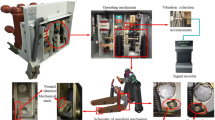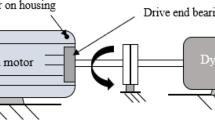Abstract
The soft failure of mechanical equipment makes its performance drop gradually, which occupies a large proportion and has certain regularity. The performance can be evaluated and predicted through early state monitoring and data analysis. In this paper, the support vector machine (SVM), a novel learning machine based on the VC dimension theory of statistical learning theory, is described and applied in machinery condition prediction. To improve the modeling capability, wavelet transform (WT) is introduced into the SVM model to reduce the influence of irregular characteristics and simultaneously simplify the complexity of the original signal. The paper models the vibration signal from the double row bearing and wavelet transformation and SVM model (WT–SVM model) is constructed and trained for bearing degradation process prediction. Besides Hazen plotting position relationships is applied to describe the degradation trend distribution and a 95 % confidence level based on \(t\)-distribution is given. The single SVM model and neural network (NN) approach is also investigated as a comparison. The modeling results indicate that the WT–SVM model outperforms the NN and single SVM models, and is feasible and effective in machinery condition prediction.










Similar content being viewed by others
Abbreviations
- SVM:
-
Support vector machine
- WT:
-
Wavelet transform
- NN:
-
Neural network
- ARMA:
-
Auto regressive moving average mode
- DWT:
-
Discrete wavelet transform
- MRA:
-
Multi-resolution analysis
- RMSE:
-
Root mean squared error
References
Chang, C. C., & Lin C. J. (2001). LIBSVM: A Library for Support Vector Machines. http://www.csie.ntu.edu.tw/~cjlin/papers/libsvm.pdf. Accessed 1 April 2005.
Chapelle, O., Vapnik, V., Bousquet, O., & Mukherjee, S. (2002). Choosing multiple parameters for support vector machines. Machine Learning, 46(1–3), 131–159.
Chen, G., & Zhou, J. (2008). Research on parameters and forecasting interval of support vector regression model to small sample. Acta Metrologica Sinica, 29(1), 92–96.
Chenoweth, H. B. (1990). Soft failures and reliability. Reliability and Maintainability Symposium. doi:10.1109/ARMS.1990.67995.
Christmann, A., & Steinwart, I. (2008). Support Vector Machines. New York: Springer.
Erdöl, N., & Basbug, F. (1992). Wavelet transform based adpative filtering. In J. Vandewalle, R. Boite, M. Moonen, & A. Oosterlinck (Eds.), Signal Processing VI: Theories and Applications (pp. 1117–1120). Amsterdam: Elsevier.
Furey, T. S., Cristianini, N., Duffy, N., Bednarski, D. W., Schummer, M., & Haussler, D. (2000). Support vector machine classification and validation of cancer tissuesamples using microarray expression data. Bioinformatics, 16, 906–914.
Guo, G., Li, S. Z., & Chan, K. L. (2001). Support vector machines for facerecognition. Image and Vision Computing, 19(9–10), 631–638.
Hansen, R. J., Hall, D. L., & Kurtz, S. K. (1995). New approach to the challenge of machinery prognostics. Journal of Engineering for Gas Turbines and Power, 117, 320–325.
He, S., He, Z., & Wang, G. (2011). Online monitoring and fault identification of mean shifts in bivariate processes using decision tree learning techniques. Journal of Intelligent Manufacturing, 1–10. doi:10.1007/s10845-011-0533-5.
Hong, W., Chen, C., et al. (2005). Recurrent support vector machines in reliability prediction. Advances in Natural Computation. Changsha: Springer.
Hsu, C. W., Chang, C. C., & Lin, C. J. (2003). A practical guide tosupport vector classification. Technical report, Department of Computer Science and Information Engineering, National Taiwan University, Taipei.
Ilhan, A., Mehmet, K., & Erhan, A. (2012). An adaptive artificial immune system for fault classification. Journal of Intelligent Manufacturing, 23, 1489–1499.
Kashani, M. N., & Aminian, J. (2012). Dynamic crude oil fouling prediction in industrial preheaters using optimized ANN based moving window technique. Chemical Engineering Research and Design, 90(7), 938–949.
Lee, J., Qiu, H., Yu, G., Lin, J., Rexnord Technical Services. (2007). ’Bearing Data Set’, IMS, University of Cincinnati. NASA Ames Prognostics Data Repository, NASA Ames, Moffett Field, CA. http://ti.arc.nasa.gov/project/prognostic-data-repository. Accessed 09 May 2009.
Lee, J., Wu, F., Zhao, W., Ghaffari, M., Liao, L., & Siegel, D. (2014). Prognostics and health management design for rotary machinery systems—Reviews, methodology and applications. Mechanical Systems and Signal Processing, 44(1), 314–334.
Li, P., Tan, Z., Yan, L., & Deng, K. (2011). Time series prediction of mining subsidence based on a SVM. Mining Science and Technology (China), 21(4), 557–562.
Ma, L., Kang, J., & Zhao, Q. (2010). Implementation of equipment residual life prediction framework based on Hidden Markov Model. Computer Simulation, 27(5), 88–91.
Mallat, S. G. (1989). A theory for multiresolution signal decomposition: The wavelet representation. Pattern Analysis and Machine Intelligence. doi:10.1109/34.192463.
Montanari, A., & Brath, A. (2004). A stochastic approach for assessing the uncertainty of rainfall-runoff simulations. Water Resources Research. doi:10.1029/2003WR002540.
Pandit, S., & Wu, S. (1983). Time series and system analysis with applications. New York: Wiley.
Taboada, J., Matias, J. M., Ordonez, C., & Nieto Garca, P. J. (2007). Creating a quality map of a slate deposit using support vector machines. Journal of Computational and Applied Mathematics, 204(1), 84–94.
Tamea, S., Laio, F., & Ridolfi, L. (2005). Probabilistic nonlinear prediction of river flows. Water Resources Research. doi:10.1029/2005WR004136.
Teng, H., Zhao, J., Jia, X., et al. (2011). Research on prediction of gear wear based on State Space Model. Mechanical Science and Technology, 12, 2086–2091.
Vapnik, V. N. (1998). Statistical Learning Theory. New York: Wiley.
Vogel, R. M. (1986). The probability plot correlation coefficient test for the normal, lognormal and Gumbel distributional hypothesis. Water Resources Research, 22(4), 587–590.
Xu, G. P., Tian, W. F., & Li, Q. (2007). EMD and SVM based temperature drift modeling and compensation for a dynamically tuned gyroscope (DTG). Mechanical Systems and Signal Processing, 21(8), 3182–3188.
Yu, P. S., Chen, S. T., & Chang, I. F. (2006). Support vector regression for real-time flood stage forecasting. Journal of Hydrology, 328(3–4), 704–716.
Zeng, Q., Qiu, J., & Liu, G. (2010). Modeling and progostics of mechanical fault based on HSMM. Mechanical Strength, 32(5), 695–701.
Zhang, Z., Wang, Y., & Wang, K. (2013). Fault diagnosis and prognosis using wavelet packet decomposition, Fourier transform and artificial neural network. Journal of Intelligent Manufacturing, 24, 1213–1227.
Acknowledgments
This work is jointly supported by the Natural Science Foundation of China (No. 51205043), the Basic Research and Development Plan of China (No. 2011CB013401) and the Special Fundamental Research Funds for Central Universities of China (No. DUT14QY21).
Author information
Authors and Affiliations
Corresponding author
Rights and permissions
About this article
Cite this article
Liu, S., Hu, Y., Li, C. et al. Machinery condition prediction based on wavelet and support vector machine. J Intell Manuf 28, 1045–1055 (2017). https://doi.org/10.1007/s10845-015-1045-5
Received:
Accepted:
Published:
Issue Date:
DOI: https://doi.org/10.1007/s10845-015-1045-5




